sensor TOYOTA RAV4 PHEV 2021 Workshop Manual
[x] Cancel search | Manufacturer: TOYOTA, Model Year: 2021, Model line: RAV4 PHEV, Model: TOYOTA RAV4 PHEV 2021Pages: 666, PDF Size: 161.28 MB
Page 413 of 666
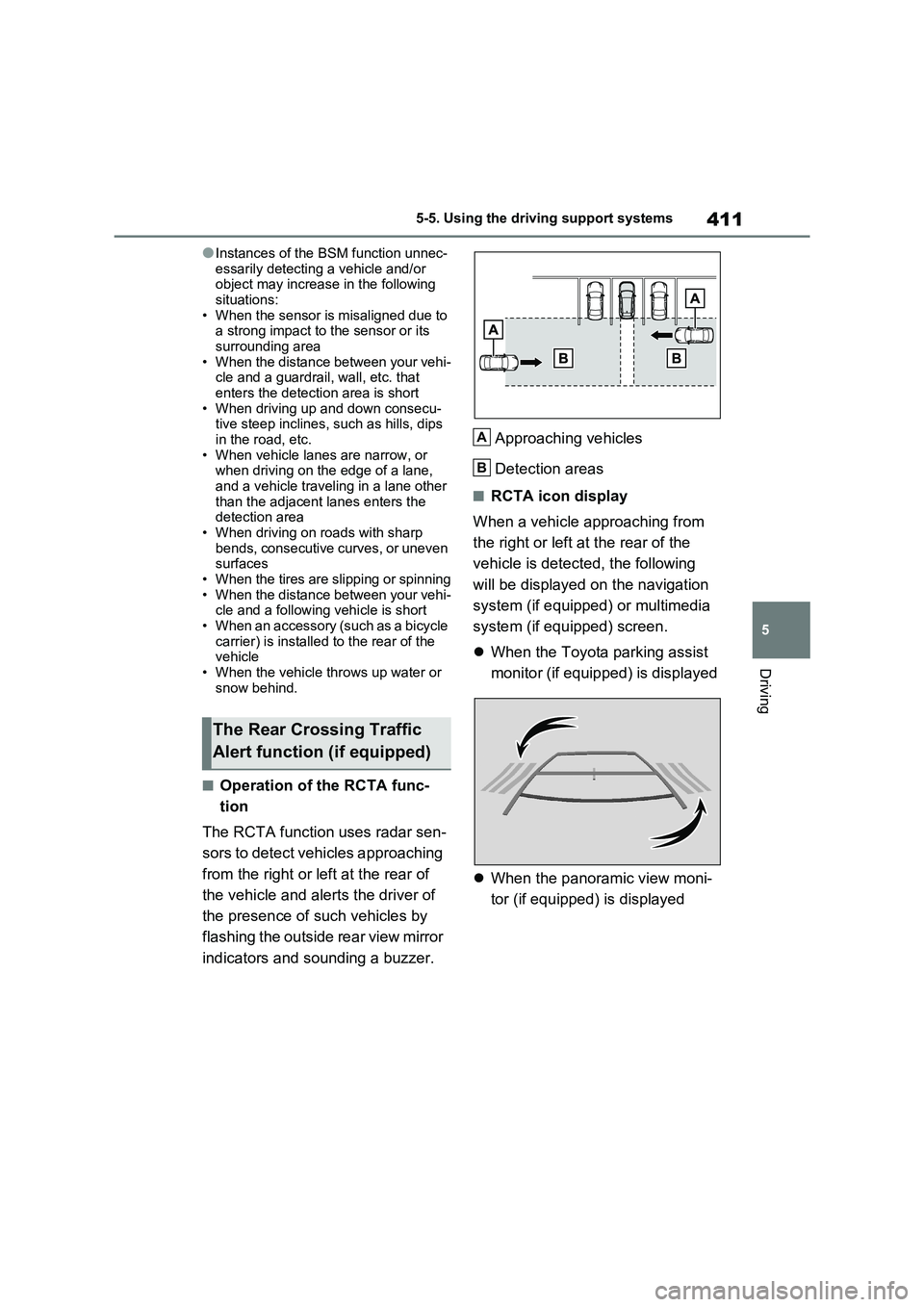
411
5
5-5. Using the driving support systems
Driving
●Instances of the BSM function unnec -
essarily detecting a vehicle and/or object may increase in the following
situations:
• When the sensor is misaligned due to a strong impact to the sensor or its
surrounding area
• When the distance between your vehi - cle and a guardrail, wall, etc. that
enters the detect ion area is short
• When driving up and down consecu - tive steep inclines, such as hills, dips
in the road, etc.
• When vehicle lanes are narrow, or when driving on the edge of a lane,
and a vehicle travel ing in a lane other
than the adjacent lanes enters the detection area
• When driving on roads with sharp
bends, consecutive curves, or uneven surfaces
• When the tires are slipping or spinning
• When the distance between your vehi - cle and a following vehicle is short
• When an accessory (such as a bicycle
carrier) is installed to the rear of the vehicle
• When the vehicle th rows up water or
snow behind.
■Operation of the RCTA func -
tion
The RCTA function uses radar sen -
sors to detect vehicles approaching
from the right or left at the rear of
the vehicle and aler ts the driver of
the presence of s uch vehicles by
flashing the outside rear view mirror
indicators and sounding a buzzer.
Approaching vehicles
Detection areas
■RCTA icon display
When a vehicle approaching from
the right or left at the rear of the
vehicle is detected, the following
will be displayed on the navigation
system (if equipped) or multimedia
system (if equipped) screen.
When the Toyota parking assist
monitor (if equipped) is displayed
When the panoramic view moni-
tor (if equipped) is displayed
The Rear Crossing Traffic
Alert function (if equipped)
A
B
Page 414 of 666
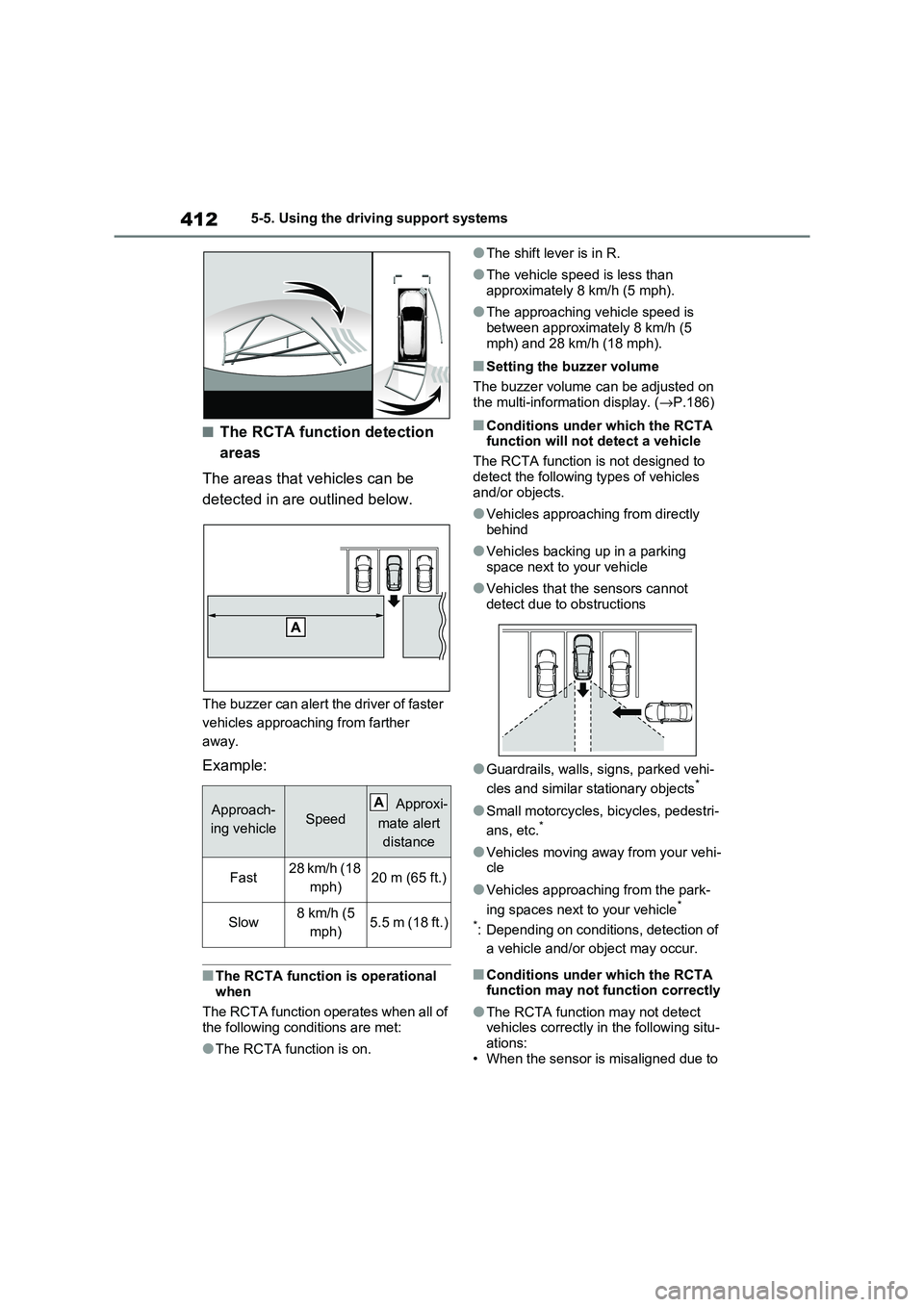
4125-5. Using the driving support systems
■The RCTA function detection
areas
The areas that vehicles can be
detected in are outlined below.
The buzzer can alert the driver of faster
vehicles approaching from farther
away.
Example:
■The RCTA function is operational
when
The RCTA function operates when all of the following conditions are met:
●The RCTA function is on.
●The shift lever is in R.
●The vehicle speed is less than
approximately 8 km/h (5 mph).
●The approaching vehicle speed is
between approximately 8 km/h (5
mph) and 28 km/h (18 mph).
■Setting the buzzer volume
The buzzer volume c an be adjusted on
the multi-information display. ( →P.186)
■Conditions under which the RCTA
function will not detect a vehicle
The RCTA function is not designed to
detect the following types of vehicles
and/or objects.
●Vehicles approaching from directly
behind
●Vehicles backing up in a parking
space next to your vehicle
●Vehicles that the sensors cannot
detect due to obstructions
●Guardrails, walls, signs, parked vehi -
cles and similar stationary objects*
●Small motorcycles, bicycles, pedestri -
ans, etc.*
●Vehicles moving away from your vehi - cle
●Vehicles approachin g from the park-
ing spaces next to your vehicle*
*: Depending on conditions, detection of
a vehicle and/or object may occur.
■Conditions under which the RCTA
function may not function correctly
●The RCTA function may not detect
vehicles correctly in the following situ - ations:
• When the sensor is misaligned due to
Approach -
ing vehicleSpeed Approxi -
mate alert
distance
Fast28 km/h (18
mph)20 m (65 ft.)
Slow8 km/h (5
mph)5.5 m (18 ft.)
A
Page 415 of 666
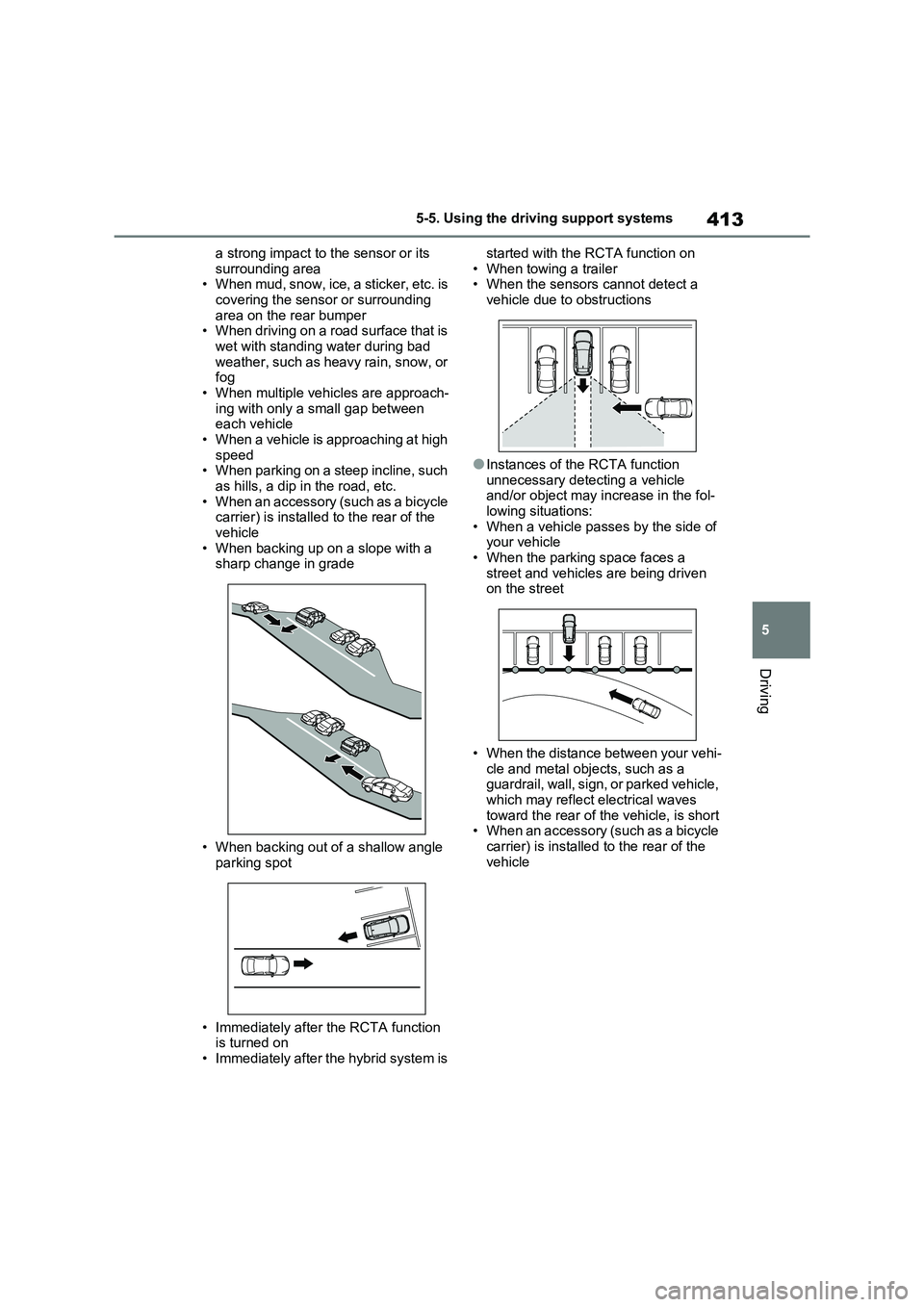
413
5
5-5. Using the driving support systems
Driving
a strong impact to the sensor or its
surrounding area • When mud, snow, ice, a sticker, etc. is
covering the sensor or surrounding
area on the rear bumper • When driving on a road surface that is
wet with standing water during bad
weather, such as heavy rain, snow, or fog
• When multiple vehicles are approach -
ing with only a sm all gap between each vehicle
• When a vehicle is approaching at high
speed • When parking on a steep incline, such
as hills, a dip in the road, etc.
• When an accessory (such as a bicycle carrier) is installed to the rear of the
vehicle
• When backing up on a slope with a sharp change in grade
• When backing out of a shallow angle
parking spot
• Immediately after the RCTA function
is turned on
• Immediately after the hybrid system is
started with the RCTA function on
• When towing a trailer • When the sensors cannot detect a
vehicle due to obstructions
●Instances of the RCTA function
unnecessary detecting a vehicle
and/or object may i ncrease in the fol- lowing situations:
• When a vehicle passe s by the side of
your vehicle • When the parking space faces a
street and vehicles are being driven
on the street
• When the distance between your vehi -
cle and metal objects, such as a guardrail, wall, sign, or parked vehicle,
which may reflect electrical waves
toward the rear of th e vehicle, is short • When an accessory (such as a bicycle
carrier) is installed to the rear of the
vehicle
Page 416 of 666
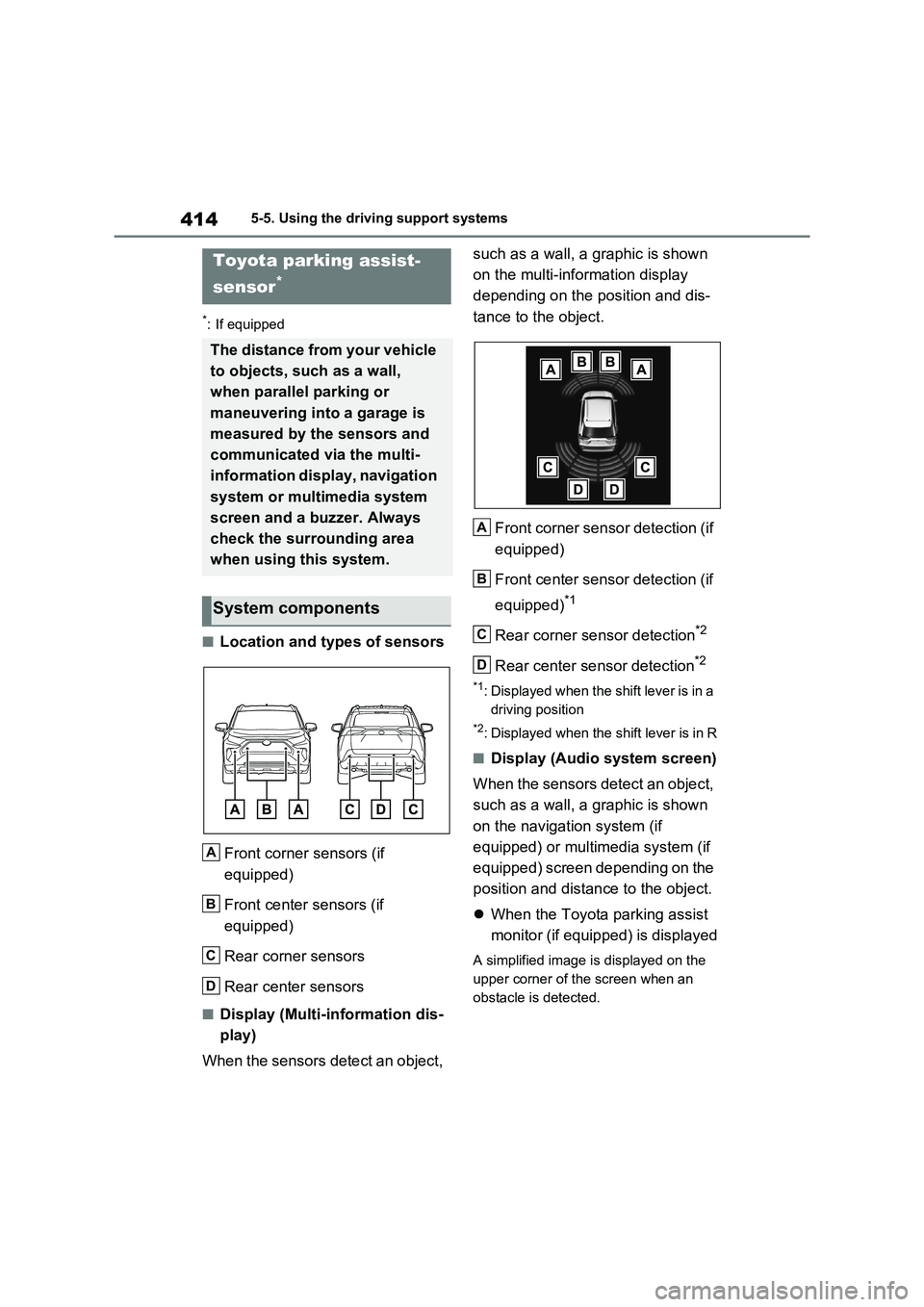
4145-5. Using the driving support systems
*: If equipped
■Location and types of sensors
Front corner sensors (if
equipped)
Front center sensors (if
equipped)
Rear corner sensors
Rear center sensors
■Display (Multi-information dis -
play)
When the sensors detect an object,
such as a wall, a graphic is shown
on the multi-information display
depending on the position and dis -
tance to the object.
Front corner sensor detection (if
equipped)
Front center sensor detection (if
equipped)*1
Rear corner sensor detection*2
Rear center sensor detection*2
*1: Displayed when the shift lever is in a
driving position
*2: Displayed when the shift lever is in R
■Display (Audio system screen)
When the sensors detect an object,
such as a wall, a graphic is shown
on the navigation system (if
equipped) or multimedia system (if
equipped) screen depending on the
position and dista nce to the object.
When the Toyota parking assist
monitor (if equipped) is displayed
A simplified image is displayed on the
upper corner of the screen when an
obstacle is detected.
Toyota parking assist-
sensor*
The distance from your vehicle
to objects, such as a wall,
when parallel parking or
maneuvering into a garage is
measured by the sensors and
communicated via the multi-
information display, navigation
system or multimedia system
screen and a buzzer. Always
check the surrounding area
when using this system.
System components
A
B
C
D
A
B
C
D
Page 417 of 666
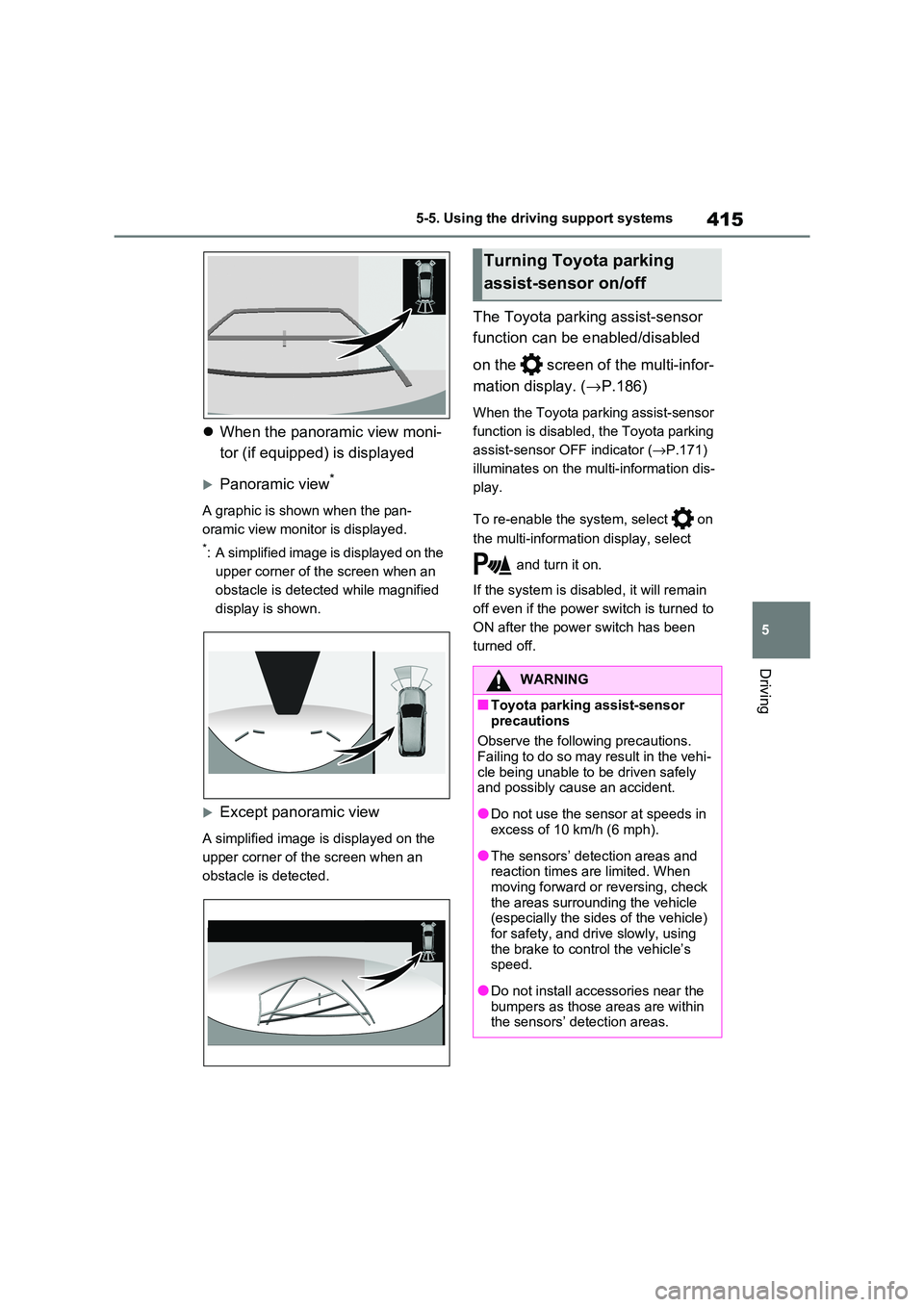
415
5
5-5. Using the driving support systems
Driving
When the panoramic view moni-
tor (if equipped) is displayed
Panoramic view*
A graphic is shown when the pan -
oramic view monitor is displayed.
*: A simplified image is displayed on the
upper corner of the screen when an
obstacle is detected while magnified
display is shown.
Except panoramic view
A simplified image is displayed on the
upper corner of th e screen when an
obstacle is detected.
The Toyota parking assist-sensor
function can be enabled/disabled
on the screen of the multi-infor -
mation display. ( →P.186)
When the Toyota parking assist-sensor
function is disabled, the Toyota parking
assist-sensor OFF indicator ( →P.171)
illuminates on the multi-information dis -
play.
To re-enable the system, select on
the multi-information display, select
and turn it on.
If the system is disabl ed, it will remain
off even if the power switch is turned to
ON after the power switch has been
turned off.
Turning Toyota parking
assist-sensor on/off
WARNING
■Toyota parking assist-sensor
precautions
Observe the following precautions. Failing to do so may result in the vehi -
cle being unable to be driven safely
and possibly cause an accident.
●Do not use the sensor at speeds in
excess of 10 km/h (6 mph).
●The sensors’ detection areas and
reaction times are limited. When moving forward or reversing, check
the areas surrounding the vehicle
(especially the sides of the vehicle) for safety, and drive slowly, using
the brake to control the vehicle’s
speed.
●Do not install acce ssories near the
bumpers as those areas are within the sensors’ detection areas.
Page 418 of 666
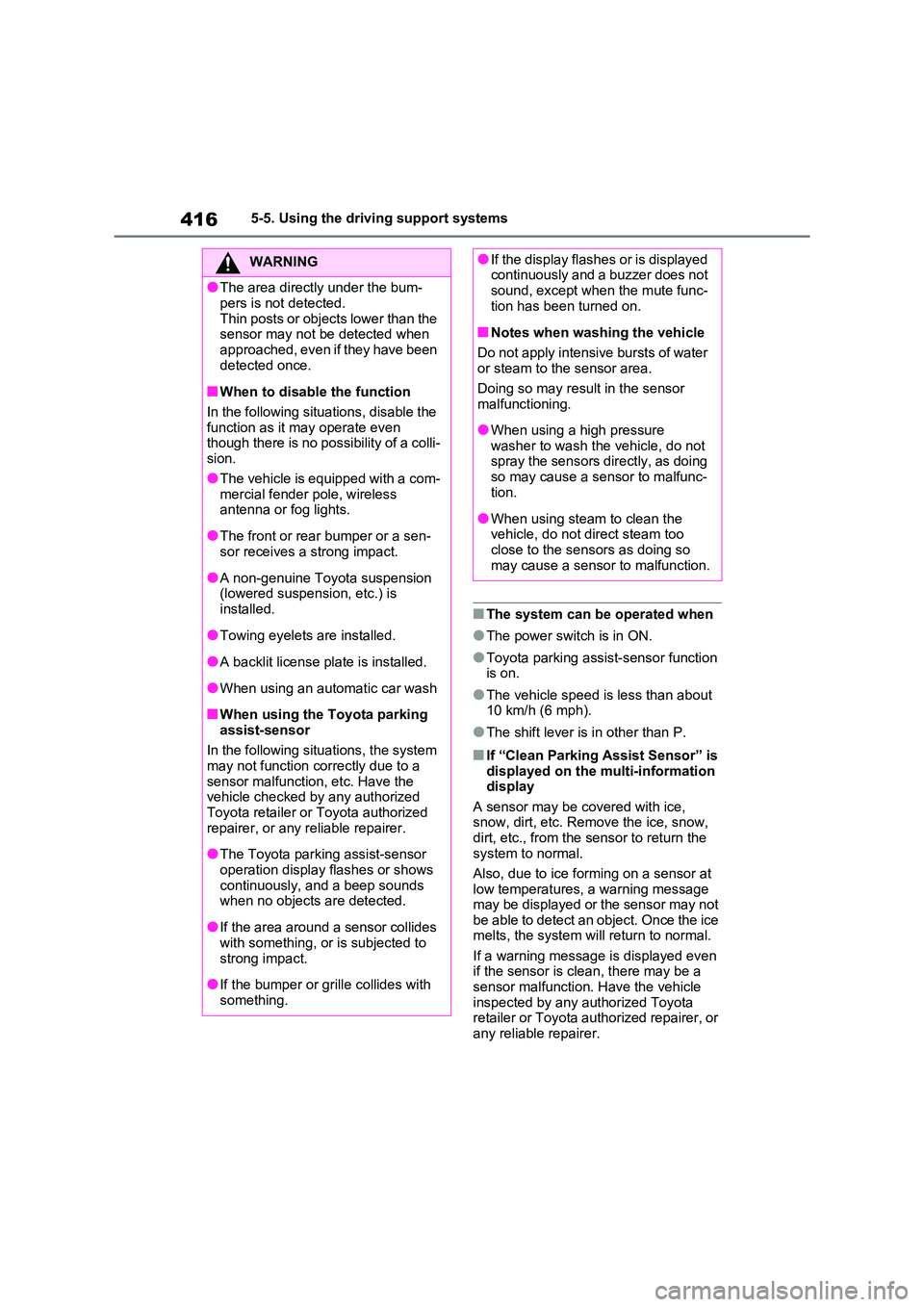
4165-5. Using the driving support systems
■The system can be operated when
●The power switch is in ON.
●Toyota parking assist-sensor function is on.
●The vehicle speed is less than about 10 km/h (6 mph).
●The shift lever is in other than P.
■If “Clean Parking Assist Sensor” is
displayed on the multi-information display
A sensor may be covered with ice,
snow, dirt, etc. Rem ove the ice, snow, dirt, etc., from the sensor to return the
system to normal.
Also, due to ice forming on a sensor at low temperatures, a warning message
may be displayed or the sensor may not
be able to detect an object. Once the ice melts, the system will return to normal.
If a warning message is displayed even
if the sensor is cle an, there may be a sensor malfunction. Have the vehicle
inspected by any a uthorized Toyota
retailer or Toyota authorized repairer, or any reliable repairer.
WARNING
●The area directly under the bum -
pers is not detected.
Thin posts or objects lower than the sensor may not be detected when
approached, even if they have been
detected once.
■When to disable the function
In the following situations, disable the
function as it may operate even though there is no possibility of a colli -
sion.
●The vehicle is equipped with a com - mercial fender pole, wireless
antenna or fog lights.
●The front or rear bumper or a sen -
sor receives a strong impact.
●A non-genuine Toyota suspension
(lowered suspension, etc.) is
installed.
●Towing eyelets are installed.
●A backlit license plate is installed.
●When using an automatic car wash
■When using the Toyota parking
assist-sensor
In the following situations, the system
may not function correctly due to a
sensor malfunction, etc. Have the vehicle checked by any authorized
Toyota retailer or Toyota authorized
repairer, or any reliable repairer.
●The Toyota parki ng assist-sensor
operation display flashes or shows continuously, a nd a beep sounds
when no objects are detected.
●If the area around a sensor collides
with something, or is subjected to
strong impact.
●If the bumper or grille collides with
something.
●If the display flashes or is displayed continuously and a buzzer does not
sound, except when the mute func -
tion has been turned on.
■Notes when washing the vehicle
Do not apply intensiv e bursts of water or steam to the sensor area.
Doing so may result in the sensor
malfunctioning.
●When using a high pressure
washer to wash the vehicle, do not spray the sensors directly, as doing
so may cause a sensor to malfunc -
tion.
●When using steam to clean the
vehicle, do not direct steam too close to the sensors as doing so
may cause a sensor to malfunction.
Page 419 of 666
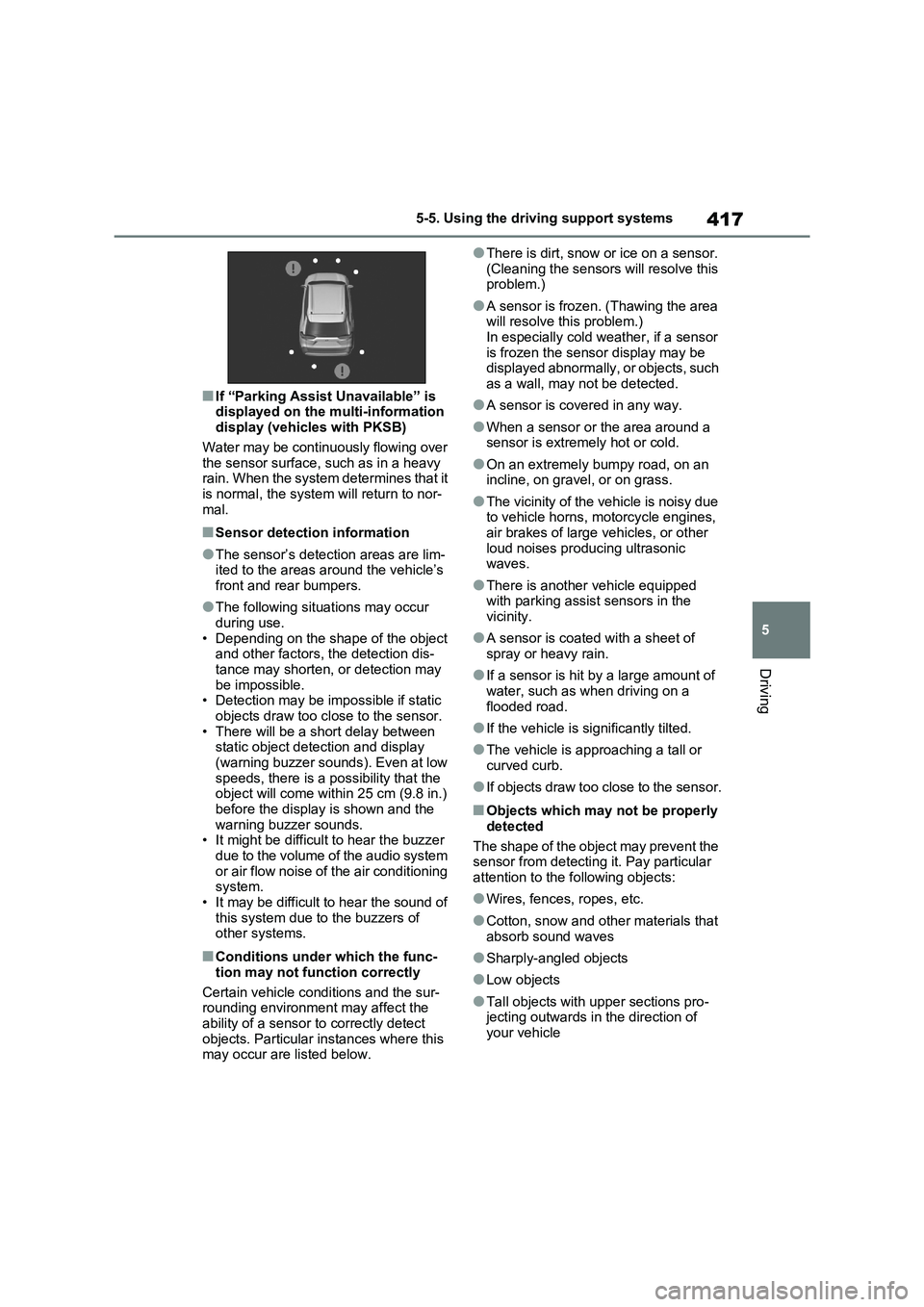
417
5
5-5. Using the driving support systems
Driving
■If “Parking Assist Unavailable” is
displayed on the multi-information display (vehicles with PKSB)
Water may be continuously flowing over
the sensor surface, such as in a heavy rain. When the system determines that it
is normal, the system will return to nor-
mal.
■Sensor detection information
●The sensor’s detec tion areas are lim-
ited to the areas aro und the vehicle’s front and rear bumpers.
●The following situations may occur during use.
• Depending on the shape of the object
and other factors, t he detection dis- tance may shorten, or detection may
be impossible.
• Detection may be impossible if static objects draw too close to the sensor.
• There will be a shor t delay between
static object detec tion and display (warning buzzer sounds). Even at low
speeds, there is a possibility that the
object will come withi n 25 cm (9.8 in.) before the display is shown and the
warning buzzer sounds.
• It might be difficu lt to hear the buzzer due to the volume of the audio system
or air flow noise of the air conditioning
system. • It may be difficult to hear the sound of
this system due t o the buzzers of
other systems.
■Conditions under which the func -
tion may no t function correctly
Certain vehicle c onditions and the sur-
rounding environment may affect the
ability of a sensor to correctly detect objects. Particular instances where this
may occur are listed below.
●There is dirt, snow or ice on a sensor.
(Cleaning the sensors will resolve this problem.)
●A sensor is frozen. (Thawing the area will resolve this problem.)
In especially cold weather, if a sensor
is frozen the sensor display may be displayed abnormally, or objects, such
as a wall, may not be detected.
●A sensor is covered in any way.
●When a sensor or the area around a sensor is extremely hot or cold.
●On an extremely bumpy road, on an incline, on grav el, or on grass.
●The vicinity of the vehicle is noisy due to vehicle horns, motorcycle engines,
air brakes of large vehicles, or other
loud noises pro ducing ultrasonic waves.
●There is another vehicle equipped with parking assist sensors in the
vicinity.
●A sensor is coated with a sheet of
spray or heavy rain.
●If a sensor is hit by a large amount of
water, such as when driving on a
flooded road.
●If the vehicle is significantly tilted.
●The vehicle is approaching a tall or
curved curb.
●If objects draw too close to the sensor.
■Objects which may not be properly
detected
The shape of the object may prevent the sensor from detecting it. Pay particular
attention to the following objects:
●Wires, fences, ropes, etc.
●Cotton, snow and other materials that
absorb sound waves
●Sharply-angled objects
●Low objects
●Tall objects with upper sections pro- jecting outwards in the direction of
your vehicle
Page 420 of 666
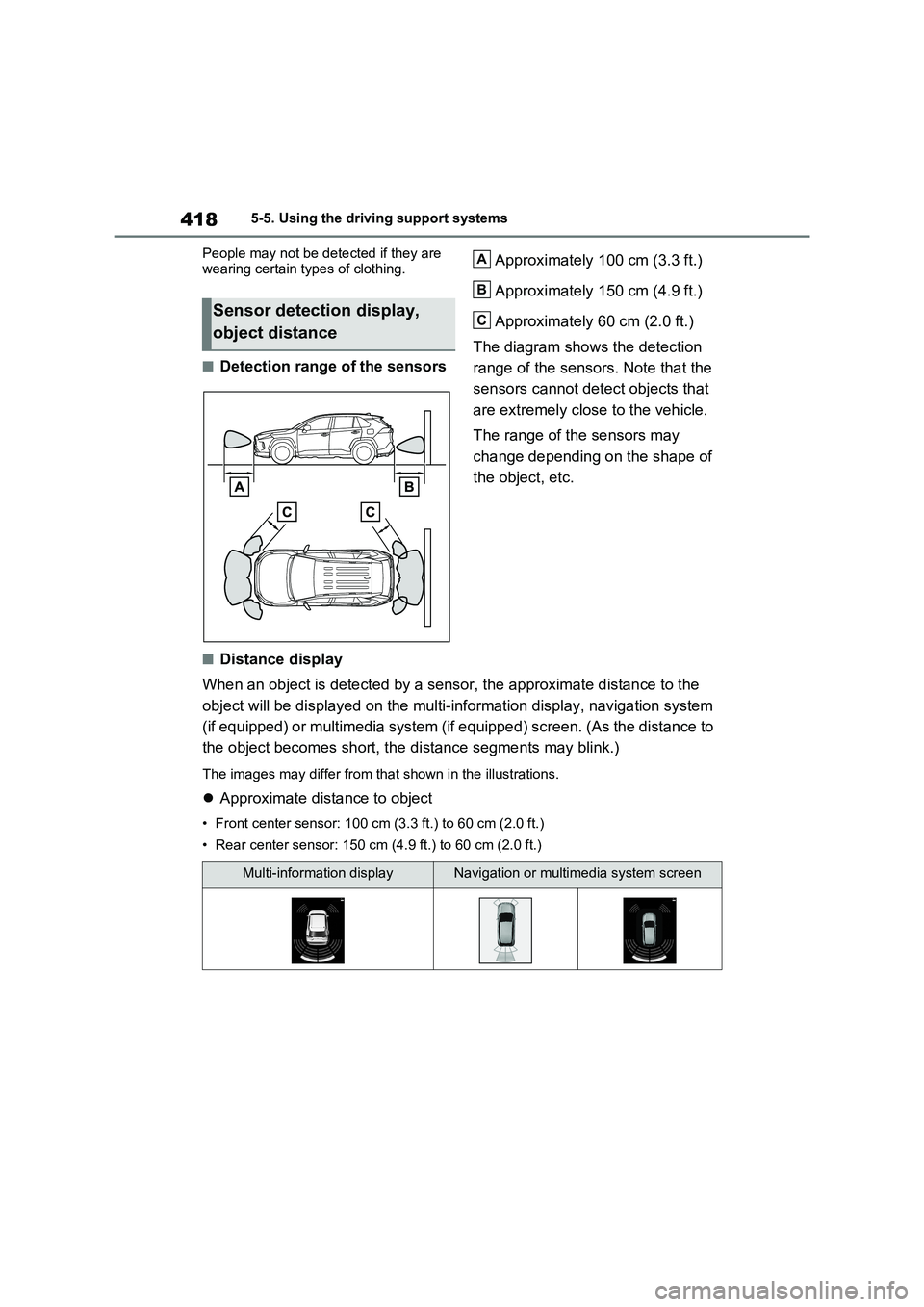
4185-5. Using the driving support systems
People may not be dete cted if they are
wearing certain types of clothing.
■Detection range of the sensors
Approximately 100 cm (3.3 ft.)
Approximately 150 cm (4.9 ft.)
Approximately 60 cm (2.0 ft.)
The diagram shows the detection
range of the sensors. Note that the
sensors cannot detect objects that
are extremely clos e to the vehicle.
The range of the sensors may
change depending on the shape of
the object, etc.
■Distance display
When an object is detected by a sensor, the approximate distanc e to the
object will be displayed on the m ulti-information display, navigation system
(if equipped) or multimedia syst em (if equipped) screen. (As the distance to
the object becomes s hort, the distance segments may blink.)
The images may differ from that shown in the illustrations.
Approximate distance to object
• Front center sensor: 100 cm (3.3 ft.) to 60 cm (2.0 ft.)
• Rear center sensor: 150 cm (4.9 ft.) to 60 cm (2.0 ft.)
Sensor detection display,
object distance
A
B
C
Multi-information displayNavigation or multimedia system screen
Page 421 of 666
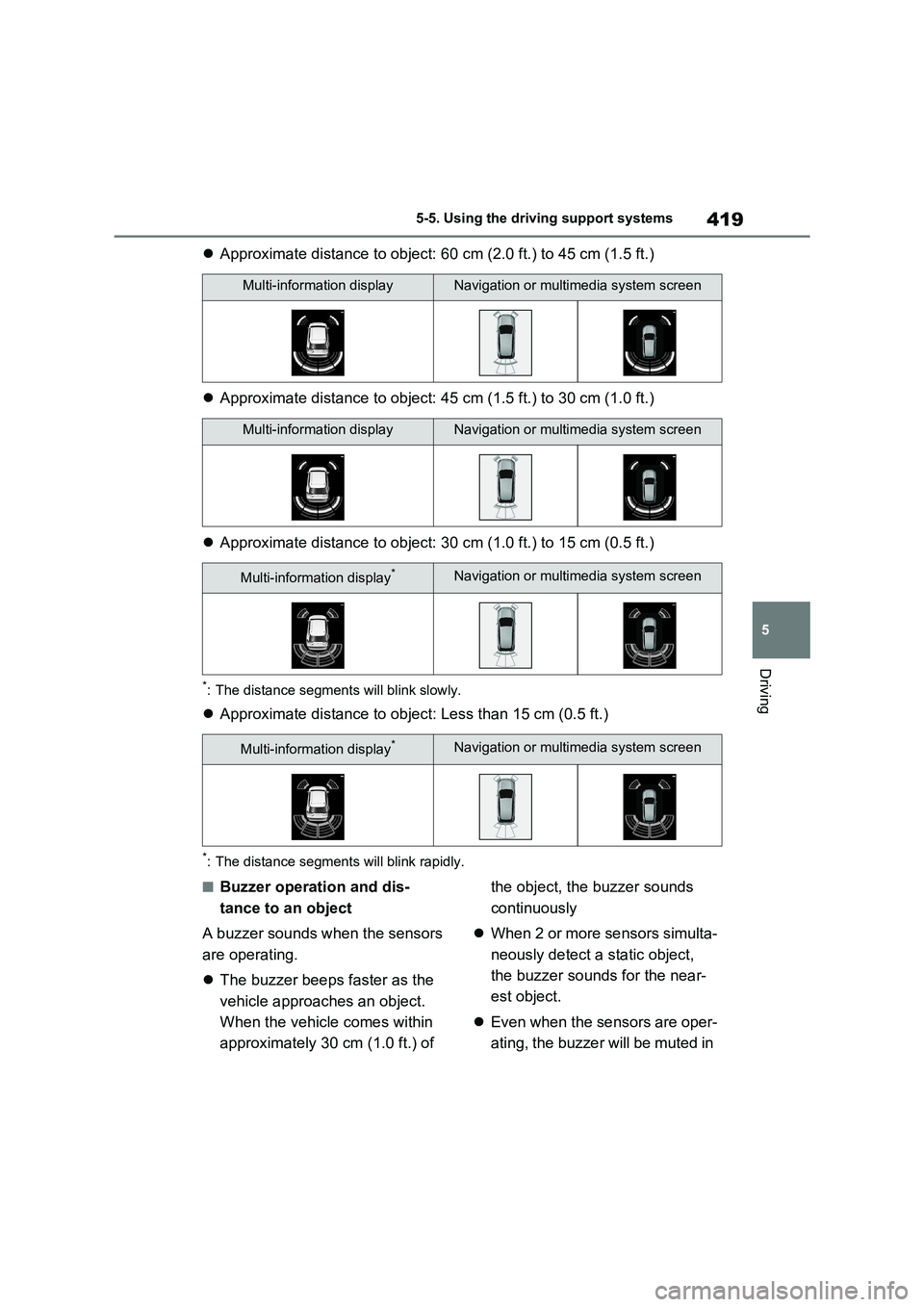
419
5
5-5. Using the driving support systems
Driving
Approximate distance to object: 60 cm (2.0 ft.) to 45 cm (1.5 ft.)
Approximate distance to object: 45 cm (1.5 ft.) to 30 cm (1.0 ft.)
Approximate distance to object: 30 cm (1.0 ft.) to 15 cm (0.5 ft.)
*: The distance segments will blink slowly.
Approximate distance to object: Less than 15 cm (0.5 ft.)
*: The distance segments will blink rapidly.
■Buzzer operation and dis-
tance to an object
A buzzer sounds when the sensors
are operating.
The buzzer beeps faster as the
vehicle approaches an object.
When the vehicle comes within
approximately 30 cm (1.0 ft.) of
the object, the buzzer sounds
continuously
When 2 or more sensors simulta-
neously detect a static object,
the buzzer sounds for the near -
est object.
Even when the sensors are oper-
ating, the buzze r will be muted in
Multi-information displayNavigation or multimedia system screen
Multi-information displayNavigation or multimedia system screen
Multi-information display*Navigation or multimedia system screen
Multi-information display*Navigation or multimedia system screen
Page 422 of 666
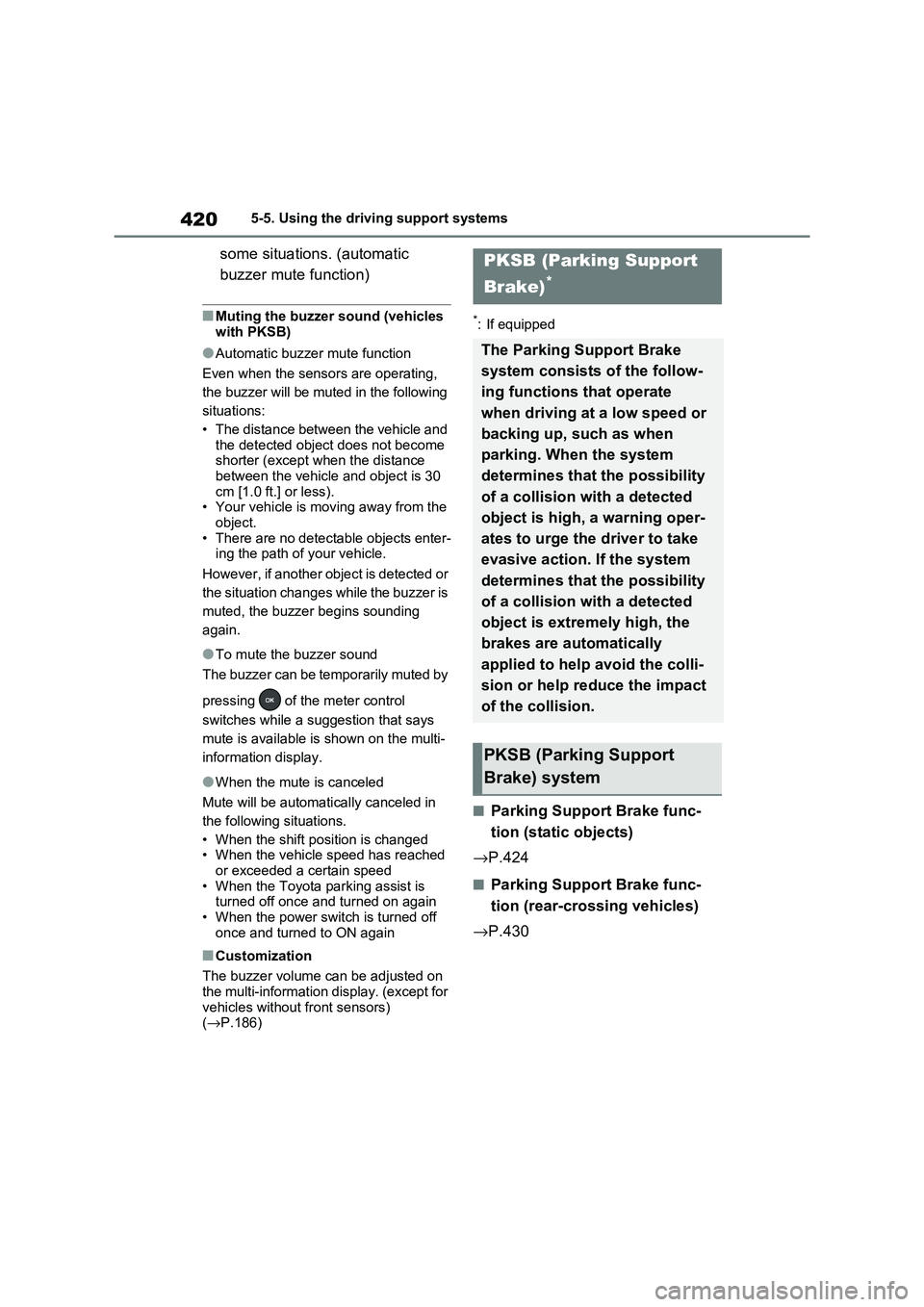
4205-5. Using the driving support systems
some situations. (automatic
buzzer mute function)
■Muting the buzzer sound (vehicles
with PKSB)
●Automatic buzzer mute function
Even when the sensor s are operating,
the buzzer will be muted in the following
situations:
• The distance between the vehicle and the detected objec t does not become
shorter (except when the distance
between the vehicle and object is 30 cm [1.0 ft.] or less).
• Your vehicle is moving away from the
object. • There are no detec table objects enter-
ing the path of your vehicle.
However, if another object is detected or
the situation changes while the buzzer is
muted, the buzzer begins sounding
again.
●To mute the buzzer sound
The buzzer can be temporarily muted by
pressing of the meter control
switches while a suggestion that says
mute is available is shown on the multi-
information display.
●When the mute is canceled
Mute will be automatic ally canceled in
the following situations.
• When the shift position is changed • When the vehicle s peed has reached
or exceeded a certain speed
• When the Toyota par king assist is turned off once and turned on again
• When the power switch is turned off
once and turned to ON again
■Customization
The buzzer volume can be adjusted on
the multi-information display. (except for
vehicles without front sensors) ( →P.186)
*: If equipped
■Parking Support Brake func-
tion (static objects)
→ P.424
■Parking Support Brake func-
tion (rear-crossing vehicles)
→ P.430
PKSB (Parking Support
Brake)*
The Parking Support Brake
system consists of the follow -
ing functions that operate
when driving at a low speed or
backing up, such as when
parking. When the system
determines that the possibility
of a collision with a detected
object is high, a warning oper-
ates to urge the driver to take
evasive action. If the system
determines that the possibility
of a collision with a detected
object is extrem ely high, the
brakes are automatically
applied to help avoid the colli -
sion or help red uce the impact
of the collision.
PKSB (Parking Support
Brake) system